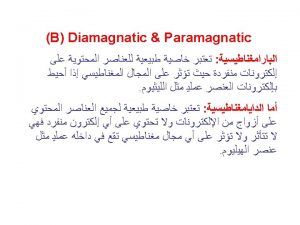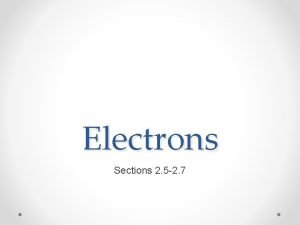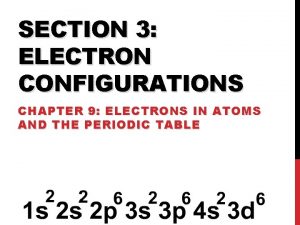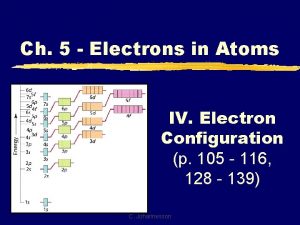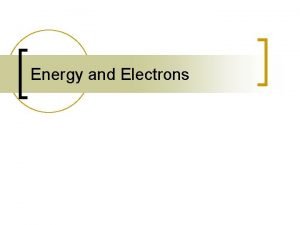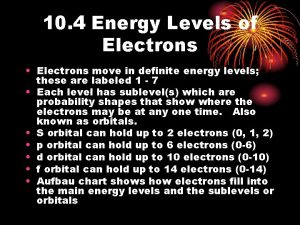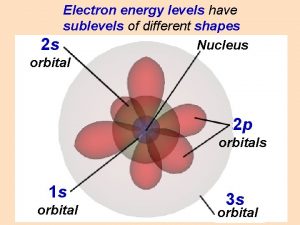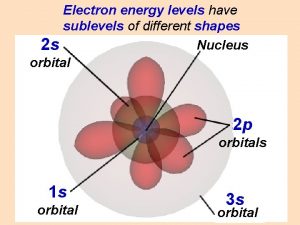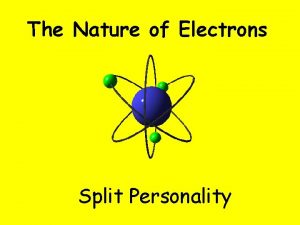Electron Energy Levels Electrons have different energy levels













- Slides: 13

Electron Energy Levels • Electrons have different energy levels – The farther the electron is from the nucleus, the more energy the electron has • Electrons “fill” the energy levels from just outside the nucleus, outward • Each of the seven energy levels have a maximum number of electrons they can hold – Energy level 1 = up to 2 electrons – Energy level 2 = up to 8 electrons – Energy level 3 = up to 18 electrons – Energy level 4 = up to 32 electrons – Etc.

Electron Configuration http: //www. chem 4 kids. com/files/elements/art/026_orbital. gif

Electron Energy Levels • Scientists keep track of the electrons to help predict an element’s behavior • The electron(s) in the highest (outermost) energy level define the chemical properties of the element and participate in chemical reactions (valence electrons) • Elements in the same group (vertical columns of elements in the periodic table with similar properties) have the same number of electrons in their outer energy level

Electron Configuration • The electron total for each element increases by 1 left to right on the periodic table – When a period ends at the far right side, the outer energy level is filled • All energy levels have sublevels called orbitals – s orbital: holds up to 2 electrons – p orbital: holds up to 6 electrons – d orbital: holds up to 10 electrons – f orbital: holds up to 14 electrons

Orbital Shapes http: //boomeria. org/chemlectures/ch 9 orbitals 1. jpg

Electron Configuration Steps for determining the electron configuration of an element: 1. Determine the number of electrons the element has. 2. Fill the lowest energy levels first and work your way up from the nucleus. 3. Each orbital “box” gets one up arrow and one down arrow. 4. Up arrows fill first, down arrows last. 5. Write the electron configuration. (energy level number)(orbital) (electrons)

Orbital Diagram

Example: Fluorine 1. Fluorine has 9 electrons. 2. Fill the lowest energy levels first and work your way up from the nucleus. 3. Each orbital “box” gets one up arrow and one down arrow. 4. Up arrows fill first, down arrows last.

Orbital Diagram for Fluorine

Example: Fluorine 1. Fluorine has 9 electrons. 2. Fill the lowest energy levels first and work your way up from the nucleus. 3. Each orbital “box” gets one up arrow and one down arrow. 4. Up arrows fill first, down arrows last. 5. Write the electron configuration.

Orbital Diagram for Fluorine 1 s 22 p 5

Orbital Diagram

Notice a Pattern? http: //www. mpcfaculty. net/mark_bishop/periodic_table_blocks_alone. jpg
 Pl7 sublevel 1/2
Pl7 sublevel 1/2 Lesson 1 electrons and energy levels
Lesson 1 electrons and energy levels Lesson 1 electrons and energy levels
Lesson 1 electrons and energy levels Electron configuration guide
Electron configuration guide Thermosoftening plastics examples
Thermosoftening plastics examples Cultural relativism
Cultural relativism Manufactured boards examples
Manufactured boards examples Unpaired electrons in electron configuration
Unpaired electrons in electron configuration Valence shell electron configuration
Valence shell electron configuration Electrons configurations
Electrons configurations Electron configuration for 5 electrons
Electron configuration for 5 electrons Energy levels on the periodic table
Energy levels on the periodic table What shape has 12 edges and 8 vertices
What shape has 12 edges and 8 vertices Electron cloud configuration
Electron cloud configuration







